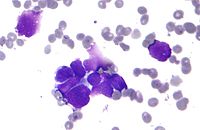
Photo from wikipedia
Tripartite motif-containing protein 11 (TRIM11) and family with sequence similarity 46B (FAM46B) have been demonstrated to play roles in prostate cancer development, but their function in paclitaxel resistance remains unclear.… Click to show full abstract
Tripartite motif-containing protein 11 (TRIM11) and family with sequence similarity 46B (FAM46B) have been demonstrated to play roles in prostate cancer development, but their function in paclitaxel resistance remains unclear. The role of TRIM11 and FAM46B in paclitaxel resistance in prostate cancer was estimated. The paclitaxel-resistant cells were established with gradually increasing concentrations of paclitaxel in prostate cancer cells. The sensitivity to paclitaxel of established cells was assessed by the value of the median inhibitory concentration in the presence of 0-1000 nM paclitaxel. The expression level of TRIM11 and FAM46B was evaluated by real-time quantitative polymerase chain reaction. The proliferation, migration, and invasion of established cells were evaluated by CCK8 and Tran-swell assay. TRIM11 was upregulated in paclitaxel-resistant cells and promoted the proliferation, migration, and invasion of established cells. The significant downregulation of FAM46B was observed in paclitaxel-resistant cells. Although the overexpression of FAM46B suppressed the viability and metastasis of paclitaxel-resistant cells, which was reversed by the upregulation of TRIM11. Both the knockdown of TRIM11 and overexpression of FAM46B could enhance paclitaxel sensitivity of established resistant cells. The promoted effect of FAM46B overexpression was alleviated by the elevation of TRIM11. TRIM11 could improve the sensitivity to paclitaxel of resistant prostate cancer cells via regulating FAM46B.
Journal Title: Critical reviews in eukaryotic gene expression
Year Published: 2022
Link to full text (if available)
Share on Social Media: Sign Up to like & get
recommendations!